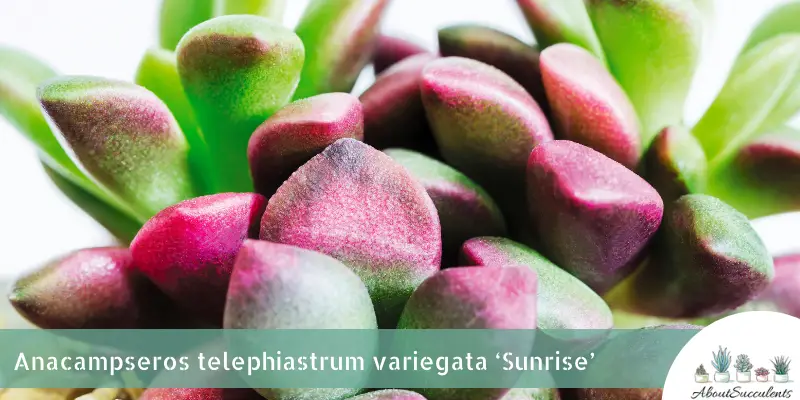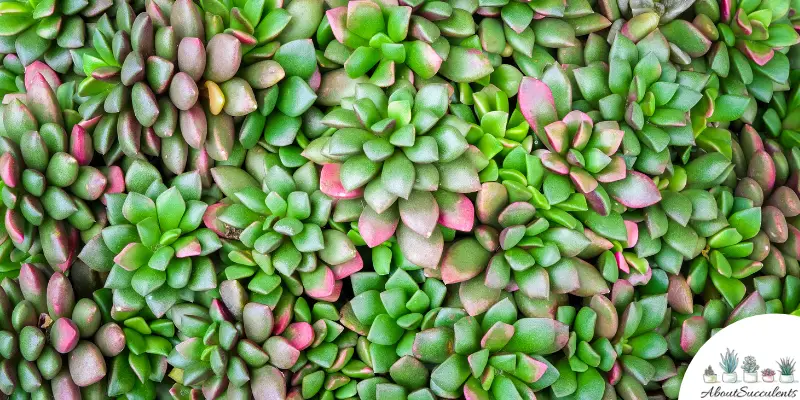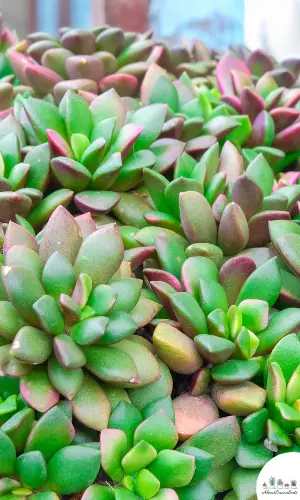
Anacampseros Telephiastrum Variegata also known as Anacampseros ‘Sunrise’ is a small variegated succulent that looks perfectly sublime in any outdoor garden or home. This slow-growing succulent plant forms a caudex as the base of the plant when it reaches maturity.
Sunrise is very popular among succulent growers because of the hues of its lanceolate leaves, a perfect combination of magenta and emerald green. Anacampseros Sunrise grows up to 15cm (6”) tall and 15 cm (6”) wide when fully grown.
As the succulent matures, the rosettes spread out horizontally forming a compact mat on the ground or spill over the edge of the pot.
In Summer, Anacampseros Telephiastrum Variegata blooms bright pink flowers up to 3.5cm (1.4”) in diameter. These adorable flowers open in the afternoon and close back at sunset.
Anacampseros Sunrise is native to South Africa. It is part of the Anacampseros genus from the Anacampserotaceae family.
General Information
Also known as: Anacampseros Telephiastrum Sunrise
Plant Family: Anacampserotaceae
Origin: South Africa
Height: 15cm (6”)
Exposure: Full to Partial Sun
Water Needs: Drought-tolerant; use the ‘soak and dry’ watering method
Soil Type: Standard cactus or succulent soil mix combined with plenty of gritty materials such as coarse sand, perlite, and pumice for added drainage.
Soil pH: 6.1 to 6.5
How to Grow and Care for Anacampseros Telephiastrum Variegata

Anacampseros Sunrise can be easily grown and cared for. Although they can be grown outdoors in raised beds, many horticulturists prefer to grow them indoors in eye-catching dish gardens.
Sunrise is not a cold-hardy succulent and will not survive at temperatures below -1.1° C (30° F).
Sunlight
If you will grow your Anacampseros Sunrise outdoors, plant them in an area where they can be exposed to full to partial sun for 5 to 6 hours every day. Plenty of bright light will keep the colors of the leaves vivid.
Lack of light will cause etiolation, where the plant loses its shape as it stretches out to seek a light source. Direct exposure to intense sunlight will burn the leaves.
If you want to bring Sunrise Indoors, place your container in an area where it can get plenty of filtered bright light for 5 to 6 hours. During winter, place the pot on a south-facing window.
Watering

Anacampseros Telephiastrum Variegata can tolerate long periods without water. The roots of succulents are vulnerable to rotting, so they should be watered sparingly.
You should use the ‘soak and dry’ watering method to prevent root rot. Water the soil deeply and then allow it to dry out completely between waterings. Before you water, insert a stick into the soil to test its level of dryness.
During the warmer seasons, water your Anacampseros Sunrise once every 7 to 10 days. As the weather gets colder, increase your watering intervals. During winter, water the soil only when it is bone dry.
Pot and Soil
The best pots to use for Anacampseros Sunshine are terracotta and ceramic. They are made with breathable materials which allow proper soil aeration. Choose pots with drainage holes.
When it comes to pot size, get one that is 10% larger in width than the diameter of your plant. A larger pot will allow the roots to grow without getting entangled and support better circulation of air in the soil.
For your potting soil, use the standard cactus or succulent soil mix. Combine it with plenty of gritty materials such as coarse sand, perlite, and pumice for added drainage.
Fertilize your succulent when it is actively growing. During summer, feed it with a high potassium fertilizer that has been diluted with water to ¼ potency.
How to Propagate Anacampseros Telephiastrum Variegata
You can increase your collection of Anacampseros Telephiastrum Variegata by using stem cuttings or seeds.
Method 1 – Stem Cuttings
Step 1: Use a sterile sharp knife or pruning shears to cut a portion of a stem.
Step 2: Leave the stem cutting in a partially shaded area for 2-3 days until the wound calluses or seals.
Step 3: Fill a terracotta pot with cactus potting soil mixed with gritty materials. Bury your stem cutting (calloused end) in the soil.
Step 4: Place the pot in an area where it can get filtered bright light. Mist the soil 4 to 5 times a day. Your plant should start rooting in two to three weeks.
Method 2 – Seeds
Step 1: Get a shallow container with drainage holes. Fill it with a well-draining potting mix. You can use store-bought succulent soil or make your own. Combine 50% loam, 40% coarse sand, and 10% perlite.
Step 2: Plant your seeds on the surface of the soil. Leave enough space between the seeds.
Step 3: Cover the container with plastic or a plant dome. Place it in a sunny area.
Step4: Mist the soil until it germinates. Remove the cover once you see sprouts.
Frequently Asked Questions
Is Anacampseros Telephiastrum Variegata Toxic to Cats and Dogs?
Anacampseros Telephiastrum Variegata is not listed as toxic to cats and dogs on the website of the American Society for the Prevention of Cruelty to Animals (ASPCA).
Why Is My Anacampseros Telephiastrum Variegata Dying?
If your Anacampseros Sunrise is looking unwell, your plant’s declining health may be caused by the following:
Overwatering
The number one cause of succulent illness is overwatering. If your plant gets more than the water it needs, it will suffer from root rot which can quickly progress to fungal infection.
You must treat your Anacampseros Sunrise immediately after seeing signs of root rot such as wrinkly, yellow, or dull green leaves.
Gently remove the plant from the pot and brush off the soil from the roots. Examine the roots carefully and cut the rotted ones with a sterile sharp knife or razor blade.
Lay the plant in a dry area. Fill a terracotta pot with cactus potting mix, sand, and perlite. Repot your succulent and wait three to four days before you water the soil.
Pest Infestation
Anacampseros Sunrise attracts mealybugs and spider mites. Remove these sap-sucking pests immediately to prevent scarring, stunted growth, or the early demise of your plant.
To remove mealybugs and spider mites, spray 70% rubbing alcohol or diluted neem oil on the affected areas. You can also spray your plant with liquid soap diluted with water. Just add a few drops of soap in 2 cups of water.
Repeat the treatment once a week until you get rid of the pests.
During treatment, place your pot in a shaded area. Exposure to bright light will cause sunburn. Make sure to isolate your infected plant to prevent the pests from contaminating other plants.
Yes, Anacampseros Telephiastrum Variegata blooms bright pink flowers in summer.
Last Updated on June 9, 2022 by Sofia Lara